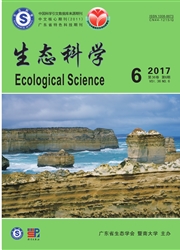

 中文摘要:
中文摘要:
通过对澧水入湖口至目平湖的样带调查,系统研究了河口区和湖心区的水体、土壤和生物学等基本生态特征及其相关关系。结果表明:(1)水流速度从河口区至湖心区几乎呈直线下降,水深是河口区大而湖心区小,其它指标如透明度和水体营养含量(硝氮、氨氮、总氮、总磷)维持在一范围内波动的趋势。(2)湖心区土壤具有较高的有机质、氮和磷含量,而河口区(壶口)的有机质、氮和磷含量相对较低。(3)河口区不适合水生植物生长,而湖心区是植物生长繁殖的主要区域,具有较高的物种丰度、生物量和多样性指数。(4)湖心区的水文和土壤环境(如适当水流和水深,肥沃的土壤)为水生植物的生长提供了良好的条件,而河口区因水流速度太大、土壤相对贫瘠等是沉水植物无法生存和发展的主要原因。相关分析进一步表明,河口区和湖心区的水体理化特征、土壤理化特征和生物学特征存在相互作用和相互影响,而水流速度是调控生态特征变化的决定性或关键因子。
 英文摘要:
英文摘要:
Basic ecological characteristics including water body, soil and biology and their correlativity were systematically studied by field investigation on the sampling belt from estuary of Lishui River to Muping Lake. The results showed that: (1) Current velocity decreased almost linearly from the estuary to central lake. Water depth was high in estuary and low in central lake. Other indices in water body such as transparency, NO^3-N, NH4^+-N, total N and total P were maintained fluctuation within a range. (2)The soil in central lake contained higher organic matter, N and P contents, while relatively lower soil organic matter, N and P contents were found in estuary. (3) Water plants could not survive in estuary, and central lake was the main regime for the growth of water plants, where had higher species richness, biomass and biodiversity. (4) The favorable hydrological and soil environments such as appropriate water flowing and fertile soil provided suitable conditions for the growth of water plants, and high current velocity and infertile soil in the central lake were the main reasons explaining for the inexistence of water plants. Correlative analysis showed that mutual effects existed among water physiological and chemical characteristics, soil physiological and chemical characteristics and biological characteristics, and that current velocity was the decisive or key factor in regulating the changes of ecological characteristics.
 同期刊论文项目
同期刊论文项目
 同项目期刊论文
同项目期刊论文
 plant distribution can ben reflected by the different growth and morphological response to water lev
plant distribution can ben reflected by the different growth and morphological response to water lev 期刊信息
期刊信息
